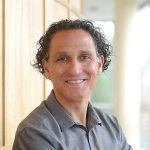Written by Daysi Flores
I spoke to Berta Cáceres the day before she was murdered. We were talking about a workshop we were doing together on collective healing and power. The last thing she said to me was, “Take care, compita.” She called everyone compita or compa, short for compañera, a political term we use for a friend in the struggle. She didn’t care who you worked for or where you came from. When she said, “This is a compa, compa,” it meant, “This person is one of us, an ally.”
By now the world knows about Berta Cáceres. An extraordinary feminist environmental activist and indigenous leader among the Lenca people in Honduras. She was a brilliant organizer and strategist, a firm and inspiring teacher, and a true internacionalista. She recognized how the Lenca communities’ struggle to protect their land and rivers was a global struggle. For more than a decade, the Council of Popular and Indigenous Organizations of Honduras (COPINH)—the community-based movement she co-led, organized one community after another building a network among 200 Lenca communities with allies across Honduras and in every part of the world. One of these communities fought for years against the construction of the Agua Zarca Dam, a hydroelectric project that would have destroyed water resources, livelihoods and displaced the community. Berta always said that she knew they would win their fight to save the river because the river itself, told her so.
After the 2009 coup in Honduras, Berta received dozens of threats for her activism, particularly in defense of the land and natural resources in Lenca territory as it seemed every inch would be auctioned off (there are 49 concessions on their land today).
On March 2, she was killed for her defense of the river Gualcarque. And she’s not the only one. Honduras is the most dangerous country in the world for environmental activists, according to Global Witness. Between 2010 and 2015, 109 people were killed there for taking a stand against destructive dams, mining, logging, or agricultural projects. Of the eight people whose deaths were reported in 2015, six were indigenous leaders.
From 2011 onward, I worked closely with Berta and other compitas to create and activate her security and protection plan while JASS and many other allies together built the National Women Human Rights Defenders Network in Honduras and the Mesoamerican Women Human Rights Defenders Initiative (known for its Spanish acronym, IMD). The IMD is a collaborative effort of six organizations that develops feminist movement-building strategies to address the specific forms of violence, stigma and sexism women human rights defenders face. Berta survived every imaginable threat – that she would be raped and killed, that her children would be raped and killed.
In 2012, while organizing protests against the proposed dam on the Rio Gualcarque in the Lenca community of Rio Blanco, Berta was picked up by a police truck, framed and taken into custody, and charged with illegal possession of weapons. Aware that she was in danger of being killed or “disappeared,” she called us, activating the network. Within hours, all of Honduras and more than 150 international and Latin American organizations began calling the Chief of Police demanding her release. After just two days, she was allowed to go home although the charges remained. She was never really safe. New accusations, charges of criminal behavior, and slander about her personal relationships and her role as a mother became public. It was difficult for her, but her commitment to saving the river and human rights activism never wavered. Nor did the attacks against her, right up until the time of her murder.
When I first heard that my friend, my teacher was assassinated, I didn’t believe it. In fact, I didn’t cry until I was coming home from the second demonstration mobilized to denounce her murder. I saw graffiti—Berta Vive—on a wall with her face, right there in front of me, and I burst into tears. I still feel like it’s a dream. If they can kill a high-profile activist like her, what does that mean for the rest of us, for the thousands of other activists in Honduras who put their lives on the line every day to demand justice and respect for people’s rights and to protect the planet?
Because Berta was one of Honduras’ most recognized human rights defenders, her murder captured worldwide attention, even in a country as violent as ours. In 2015, she received the prestigious Goldman Environmental Prize, which honors grassroots activists. She and COPINH have many allies around the world because of their active involvement on so many issues important to indigenous peoples and to Honduras. The power of her story and the vast networks tied to her and COPINH unleashed an explosion of activism after her murder, mobilizing environmentalists, feminists, indigenous rights leaders, and human rights advocates around the world, who are still calling—in a loud, collective voice—for those responsible to be held accountable and for an end to construction of dams and other projects that threaten people’s lives. As I write, FMO—the Dutch investors in the Agua Zarca dam project—have announced they will pull out of the project.
Two weeks after her murder, JASS worked with many international groups and donors to pull together a delegation of Honduran women defenders to the U.N. Commission on the Status of Women. The delegation, which included the co-coordinator of COPINH, was led by Bertha Zúniga Cáceres, Berta’s daughter, who testified before the plenary on March 18. In her testimony, Bertha Cáceres called for the creation of an independent expert group supported by the Inter-American Commission on Human Rights to investigate her mother’s murder and for the Honduran government to take steps to end a culture of impunity. She received a standing ovation. The trip to New York was the first international visit led by Bertha Cáceres, COPINH, and other Honduran justice leaders; since then, there have been two other delegations to the U.S. and a full tour of Europe.
These delegations, along with steady international pressure of smart advocates and media, have already borne fruit. At the end of March, Mexican environmentalist and journalist Gustavo Castro Soto, who was with Cáceres at the time of her murder and was shot twice in the attack, was allowed to return home after being held in custody for weeks. The decision to suspend their investment in the dam by FMO is another byproduct of this collective outcry.
Earlier this month, five men were charged with Cáceres’ murder, including a mid-level employee of Desarollos Energéticos (DESA), the Honduran company leading the dam project. Despite our best efforts, Cáceres couldn’t be protected at all times. But people who work to protect the environment and their communities shouldn’t need protection. The Honduran government must come clean about its role in the systematic persecution of indigenous and environmental leaders under its watch. It must end the careless destruction of land belonging to indigenous peoples and the persecution and criminalization of activists demanding justice and democracy, and start listening to local communities who have their own proposals for how to improve their own lives and simultaneously protect the planet. Cáceres called this idea “People’s power.”
Now it is the vision of millions. We have a song in Honduras with a slogan that has since been echoed around in the world: “Berta didn’t die; she multiplied.”


























